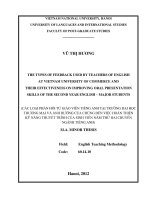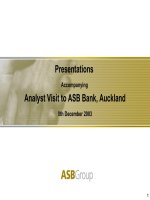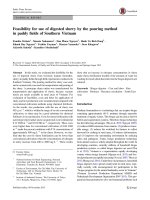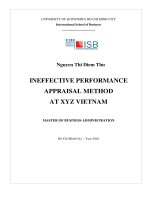Benchmarking circulars vietnam method presentation at MOIT september 2019 2
Bạn đang xem bản rút gọn của tài liệu. Xem và tải ngay bản đầy đủ của tài liệu tại đây (914.91 KB, 30 trang )
MOIT (EESD) and The Danish Energy Agency
Benchmarking of Industrial Energy Consumption
MOIT
13 SEPTEMBER 2019
1
9/8/22
PURPOSE WITH MEETING
• Present and discuss benchmarking concept (method) (memo forwarded before meeting)
• Present and discuss guidelines for enterprises based on draft memos of:
1)
2)
3)
4)
Guideline for calculate/determine SEC-Target (forwarded before meeting)
Guideline for how to calculate current SEC-value (forwarded before meeting)
Guideline for how to assess deviation between SEC-Target and SEC-value (not forwarded)
Guideline for the plan/roadmap for meeting the SEC-target in the coming 3-5 years (content,
reporting (format), controlling etc.) (not forwarded)
• Agree on further steps regarding guidelines and procedures for benchmarking including:
I.
II.
III.
IV.
2
9/8/22
Input from two breweries and DOITs (2-4 partner DOITs)
Finalization of guidelines
Preparing DOIT-procedures for administering the benchmarking circulares
Preparing for the WS in Nov/Dec – should guidelines and procedures be conculcated?
BENCHMARKING METHODOLOGY
3
9/8/22
SOME DEFINITIONS…
SEC-Target:
The target for a given sector and production type/volume stated in the relevant benchmarking circular
(Circular 19 for Beer and Beverage Industry).
If the production is a mix of products stated in the circular, the SEC-Target has to be calculated by the
enterprise.
SEC-Value:
The actual SEC of the production facility. Based on actual energy consumption and production volume at
the facility.
The actual SEC can be based on metering (one or more meters) the energy consumption in the production
facility or by “best assumptions” of the energy consumption. The production volume can be related to
different types of products.
4
9/8/22
IDEWORKSHOP DEN 24. OKTOBER 2018
OVERALL METHODOLOGY APPROACH /1
• The methodology is based on a combination of a “explanatory” and a
“hard” approach.
• Obligations for the enterprises:
• Each year the enterprise have to:
5
1.
Determine the SEC-Target for the production site based on last years production
mix and volume
2.
Calculate the actual SEC-Value for the production site based on last years
production volume and energy consumption
3.
Clarify the deviation between SEC-Target and current SEC-Value
4.
Prepare a plan (roadmap) for the coming 3-5 years for how to bring SEC-Value
closer to SEC-Target.
5.
Report 1-4 to the DOIT using the templates in the circular.
9/8/22
OVERALL METHODOLOGY APPROACH /2
• Obligations for the DOIT:
•
Each year the DOIT have to (to be discussed with the DOITs):
1. Control if the enterprise comply with the circular by controlling the
yearly report from the enterprises (procedures are to be developed)
2. Be in dialogue with the enterprises to give inspiration for energy
measures and information on the obligations to comply with the
benchmarking circulars (to be discussed)
3. Give cautions and fines if the enterprise do not meet the SEC-Target
or hand in a realistic roadmap (to be clarified in Decree 134).
• In general the methodology is developed for DEUs but can be used by
non-DEUs as well. Needed changes/other requirements/approaches
for the non-DEUs have to be discussed
6
9/8/22
DELIVERABLES
• 4 guidelines for enterprises:
1) Determine the SEC-Target
2) Calculate the current SEC-Value
3) Assess the deviation between SEC-Target and SEC-Value
4) How to prepare plan for meeting the SEC-Target
• Memo with results from testing the guidelines at two breweries
• Concept note on DOIT-procedures on how to administer the benchmarking circulars
• Input to MOIT to relevant changes of Circular 09 and Decree 134.
7
9/8/22
IDEWORKSHOP DEN 24. OKTOBER 2018
GUIDELINE FOR ENTERPRISES
ON HOW TO DETERMINE THE
SEC-TARGET
8
9/8/22
DETERMINE SEC-TARGET
• A step-by-step guide for the enterprises. DOITs will also use this guide.
• Two ways to determine the SEC-Target:
• The production mix is stated directly in the circular:
• Based on production volume and year the SEC-Target can be looked up in the circular directly
• The production mix is not stated directly in the circular:
• The SEC-Target can not be looked up directly in the circular and needs to be calculated:
The calculation is a direct weight of the SEC-Target for the different product mix
• The SEC-Target have to be determined each year, because:
• The production volume can vary from year to year
• The circular have different SEC-Targets for periods (2016-2020 and 2020-2025).
9/8/22
9
ASSESSMENT OF TECHNOLOGY SPECIFIC IMPROVEMENTS – EXAMPLE 1
• Brewery 1 Production:
• Bottled beer:
• Canned beer:
970,000 hl
1,415,000 hl
• Draught beer:
15,000 hl
• Total:
2,400,000 hl
• Inputs
• Reporting year:
• Beer Production
SECTarget,beer
[MJ/hl]
Beer
Production
[106 l/y]
9/8/22
2018
240,000,000 l
Reporting Year
[2016;2020]
>100
[20-100]
<20
140
215
306
[2021;2025[
129
196
286
10
ASSESSMENT OF TECHNOLOGY SPECIFIC IMPROVEMENTS – EXAMPLE 2
• Brewery 2 Production:
• Bottled beer:
• Canned beer:
• Draught beer:
• Total:
68,209 hl
316,504 hl
38,043 hl
522,756 hl
• Inputs
• Reporting year:
• Beer Production
SECTarget,beer
[MJ/hl]
Beer
Production
[106 l/y]
9/8/22
2018
52,275,600 l
Reporting Year
[2016;2020]
>100
[20-100]
<20
140
215
306
[2021;2025[
129
196
286
11
GUIDELINE FOR ENTERPRISES
ON HOW TO CALCULATE THE
CURRENT SEC-VALUE
12
9/8/22
CALCULATE SEC-VALUE
• A step-by-step guide for the enterprises. DOIT will also use this guideline.
• The basic calculation is relatively simple:
• BUT….
A special weighting is applied to product volumes to obtain “equivalent production volume”
Only energy consumption in production areas should be included – if no or few meters and/or a mix
of energy sources the energy consumption must be calculated based on other data (procurement)
and (qualified) assumptions.
If there is a mix of products the site equivalent product must be calculated based on the production
mix and data from the circular – and again this might be based on (qualified) assumptions or real
(production or sales) data if any. Energy consumption must also be split according to the product
mix.
• Important that any (qualified) assumptions are described/documented
9/8/22
13
SEC-VALUE – EXAMPLE 1
• Brewery 1 Production:
• Bottled beer:
• Canned beer:
Equivalent Product Volumes P(E) & P(T)
970,000 hl
1,415,000 hl
• Draught beer:
15,000 hl
• Total:
2,400,000 hl
• Brewery 1 Energy Consumption:
• Electricity Consumed:
• Diesel Oil Consumed:
9/8/22
Energy Consumption E1 & T1
15,300 MWh/y
28,400 l/y
14
SEC-VALUE – EXAMPLE 1
• SEC-Value:
• Comments:
• SEC significantly below target.
• Thermal consumption seems too low,
from experience, could be a unit error.
9/8/22
15
SEC-VALUE – EXAMPLE 2
• Brewery 2 Production:
• Bottled beer:
• Canned beer:
• Draught beer:
• Total:
Equivalent Product Volumes P(E) & P(T)
68,209 hl
316,504 hl
38,043 hl
522,756 hl
• Brewery 2 Energy Consumption:
• Electricity Consumed:
• Coal Consumed:
9/8/22
Energy Consumption E1 & T1
4,846 MWh/y
2,577 ton/y
16
SEC-VALUE – EXAMPLE 2
• SEC-Value:
• Comments:
• Coal quality unknown, an intermediate
coal quality is used.
• SEC barely missing target.
9/8/22
17
GUIDELINE FOR ENTERPRISES
ON HOW TO ASSESS
DEVIATIONS BETWEEN SECTARGET AND SEC-VALUE
18
9/8/22
ASSESS DEVIATION BETWEEN SEC-TARGET AND -VALUE
• A
step-by-step guide for the enterprises including sector specific technology best practice. DOIT will
also use this guideline.
• Step 1 is to calculate the deviation:
• The basic calculation is relatively simple:
• If SEC-deviation > 0 = the production is energy efficient
• If SEC-deviation < 0 = there might be a potential for improving the energy efficiency
• Step 2 is to compare the SEC-deviation from the current year with the SEC-deviation from last year.
• Step 3 – only if SEC-deviation < 0 an analysis of the possible improvements by technologies should be
made – continue to step 4
9/8/22
19
POTENTIAL FOR TECHNOLOGY SPECIFIC IMPROVEMENTS
• Method:
• Step 4: An enterprise consist of a number of production technologies and utility systems. The most significant
have to be examined
• Step 5: For each significant production technology and utility system, the actual level of energy efficiency in
the company should be assessed as compared to best practice using the new technology specific guideline
for the specific industrial sector
• Step 6: The enterprise shall wrap-up conclusions on which deviations in energy efficiency that has been
observed area by area. For the DEUs this can be done as a part of the energy audit.
• Discussion:
a. Should only the most significant production technologies and utility systems be examined, or should all (7-8)
the technologies and utility systems mentioned in the new guideline be examined?
b. Should the enterprise make assessment of each technology and utility system even if the SEC-deviation > 0
and report this to DOIT?
9/8/22
20
ASSESSMENT OF TECHNOLOGY SPECIFIC IMPROVEMENTS – EXAMPLE 1
9/8/22
21
ASSESSMENT OF TECHNOLOGY SPECIFIC IMPROVEMENTS – EXAMPLE 2
9/8/22
22
GUIDELINE FOR ENTERPRISES
ON HOW TO PREPARE ANNUAL
PLAN TO BRING SEC-VALUE
CLOSER TO SEC-TARGET
23
9/8/22
PLAN TO BRING SEC-VALUE CLOSER TO SEC-TARGET
• A step-by-step guide for the enterprises. DOIT will also use this guideline.
• Based on the assessment of the potential for EE of the most significant/all technologies and utility
systems the enterprise must prepare a plan for how to meet (or get close to) the SEC-Target within the
coming 3-5 years. This plan will focus on each of the relevant technologies and utility systems within the
production facility.
• Method:
• Step 1: The enterprise must select a realistic and ambitious numbers of technologies and/or utility systems that will be
improved within the next year and within the next 3-5 years
• Step 2: For each selected technology/utility system the enterprise must prepare a project implementation plan
• Step 3: Based on the project implementation plan the enterprise must determine the expected SEC for the coming year
• Step 4: Based on the project implementation plan the enterprise must determine the expected time before the
enterprise will meet the SEC-Target set in the sector specific circular (or calculated SEC-Target)
9/8/22
24
GUIDELINE FOR ENTERPRISES
GENERAL REMARKS AND
DISCUSSION
25
9/8/22









